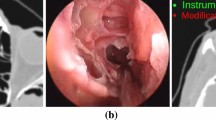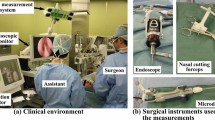Abstract
Purpose
This study proposes a method to analyze surgical performance by modeling, aligning, and comparing surgical processes. This method is intended to serve as a means to support the enhancement of surgical skills for endoscopic sinus surgeries (ESSs). We focus on surgical navigation systems used in image-guided ESSs and aim to construct a comparative analysis method for surgical processes based on the information about the surgical instruments motion obtained from the navigation system.
Methods
The proposed method consists of the following three parts: quantification of surgical features, modeling of surgical processes, and alignment and comparison of surgical process models (SPMs). First, we defined time-series parameters using the navigation-based surgical data. Second, we created SPMs by applying the defined parameters and the relative positional information of the instruments to the patient’s anatomy. Third, we constructed a method to align and compare SPMs based on dynamic time warping with barycenter averaging.
Results
The proposed method was validated on a dataset containing surgical data obtained by an optical tracking system from 14 clinical ESS cases. We evaluated the validity of the comparative analysis by aligning and comparing SPMs between experts and residents. The validation results suggested that the proposed method could achieve proper alignment of the SPMs and clarify the differences in surgical processes between experts and residents.
Conclusion
We developed a method to enable a time-series comparative analysis of surgical processes based on the surgical data from the navigation system. This method can allow surgeons to identify differences between their procedures and reference procedures such as experts’ procedures.








Similar content being viewed by others
References
Eliashar R, Sichel JY, Gross M, Hocwald E, Dano I, Biron A, Ben-Yaacov A, Goldfarb A, Elidan J (2003) Image guided navigation system-a new technology for complex endoscopic endonasal surgery. Postgrad Med J 79:686–690
Stankiewicz JA, Lal D, Connor M, Welch K (2011) Complications in endoscopic sinus surgery for chronic rhinosinusitis: a 25-year experience. Laryngoscope 121:2684–2701
Oropesa I, Sánchez-González P, Chmarra MK, Lamata P, Fernández A, Sánchez-Margallo JA, Jansen FW, Dankelman J, Sánchez-Margallo FM, Gómez EJ (2013) EVA: laparoscopic instrument tracking based on Endoscopic Video Analysis for psychomotor skills assessment. Surg Endosc 27:1029–1039
Hofstad EF, Våpenstad C, Chmarra MK, Langø T, Kuhry E, Mårvik R (2013) A study of psychomotor skills in minimally invasive surgery: what differentiates expert and nonexpert performance. Surg Endosc 27:854–863
Lalys F, Jannin P (2014) Surgical process modelling: a review. Int J Comput Assist Radiol Surg 9:495–511
Franke S, Meixensberger J, Neumuth T (2015) Multi-perspective workflow modeling for online surgical situation models. J Biomed Inform 54:158–166
Morineau T, Riffaud L, Morandi X, Villain J, Jannin P (2015) Work domain constraints for modelling surgical performance. Int J Comput Assist Radiol Surg 10:1589–1597
Holden MS, Ungi T, Sargent D, McGraw RC, Chen EC, Ganapathy S, Peters TM, Fichtinger G (2014) Feasibility of real-time workflow segmentation for tracked needle interventions. IEEE Trans Biomed Eng 61:1720–1728
Ahmidi N, Poddar P, Jones JD, Vedula SS, Ishii L, Hager GD, Ishii M (2015) Automated objective surgical skill assessment in the operating room from unstructured tool motion in septoplasty. Int J Comput Assist Radiol Surg 10:981–991
Nakamura R, Aizawa T, Muragaki Y, Maruyama T, Iseki H (2012) Automatic surgical workflow estimation method for brain tumor resection using surgical navigation information. J Robot Mechatron 24:791–801
Sugino T, Kawahira H, Nakamura R (2017) Comprehensive surgical task analysis on image-guided surgery. J Med Imaging Health Inform 7:780–787
Forestier G, Petitjean F, Riffaud L, Jannin P (2014) Non-linear temporal scaling of surgical processes. Artif Intell Med 62:143–152
Sakoe H, Chiba S (1978) Dynamic programming algorithm optimization for spoken word recognition. IEEE Trans Acoust Speech Signal Process 26:43–49
Petitjean F, Ketterlin A, Gançarski P (2011) A global averaging method for dynamic time warping, with applications to clustering. Pattern Recognit 44:678–693
Acknowledgements
This research was supported by the Grants-in-Aid (KAKENHI) from the Ministry of Education, Culture, Sports, Science and Technology (MEXT; Nos. 24103704 and 15H03029), JST PRESTO (JPMJPR16D9), and the Research Grant (C) from the Tateishi Science and Technology Foundation.
Author information
Authors and Affiliations
Corresponding author
Ethics declarations
Conflict of interest
The authors declare that they have no conflict of interest.
Ethical approval
All procedures performed in studies involving human participants were in accordance with the ethical standards of the institutional and/or national research committee and with the 1964 Helsinki Declaration and its later amendments or comparable ethical standards.
Informed consent
Informed consent was obtained from all individual participants included in the study.
Rights and permissions
About this article
Cite this article
Sugino, T., Nakamura, R., Kuboki, A. et al. Comparative analysis of surgical processes for image-guided endoscopic sinus surgery. Int J CARS 14, 93–104 (2019). https://doi.org/10.1007/s11548-018-1855-y
Received:
Accepted:
Published:
Issue Date:
DOI: https://doi.org/10.1007/s11548-018-1855-y




